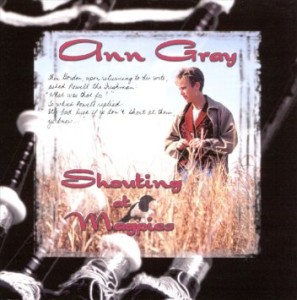 It is really refreshing to see top-caliber pipers taking the bagpipe to new horizons. In the past, many Great Highland bagpipers that have pursued the bagpipe beyond the strictly traditional have tended to be the pipers that didn’t have enough talent to cut it in the highly competitive, strictly traditional bagpipe world. Recent years have seen a new trend of interest in music outside of the Highland pipe’s traditional milieu. One such piper to break new ground is Ann Gray.
It is really refreshing to see top-caliber pipers taking the bagpipe to new horizons. In the past, many Great Highland bagpipers that have pursued the bagpipe beyond the strictly traditional have tended to be the pipers that didn’t have enough talent to cut it in the highly competitive, strictly traditional bagpipe world. Recent years have seen a new trend of interest in music outside of the Highland pipe’s traditional milieu. One such piper to break new ground is Ann Gray.
Typical Great Highland bagpipe solo albums tend to strictly adhere to certain principles. The first is that there are no other instruments represented, beside the pipes. Also, the music played is traditional, or traditional in nature, and is put forward in the standard set styles of bagpipe repertoire. The result is a collection of outstanding tunes, played by outstanding players, which would unfortunately hold little interest to the average listener. The lack of variety in sound and tone would bore many non-pipers in no time at all.
Ann Gray is no stranger to the finer points of the Great Highland bagpipe, having won such prestigious piping awards as the 1995 Dunvegan Medal and the 1997 Atlantic Canada Piobaireachd Championship. Her fingering, finesse, and expression can easily stand alongside any of the top pipers of today. Yet her interests expand beyond the study of piobaireachd, marches, and dance tunes. She incorporates a variety of instruments and traditions in her new and outstanding recording, Shouting at Magpies. Joined by Jackie Bell on violin and vocals, Diane Kooch on bass, Robin Tufts on percussion, Roger Helfrick on Celtic harp, and Lillian Penner on cello, not to mention several other musicians, Gray has created a diverse and complex album.
This recording is filled with spice and variety. Opening with a set of original jigs on the pipes, backed by guitar, violin, bass, djembe, and bodhran, Gray sets the scene for the music to come. Gray’s use of other ethnic instruments bring a delightful mix of world music to the Scottish bagpipe sound. “Senor Celtic y el Grupo” combines Spanish guitar, djembe, and shakers with the Scottish smallpipes, to create a delightful Spanish/Celtic concoction. On another track, “The Broadview Set,” Gray plays several traditional jigs on the mellow and beautiful shuttle pipes, backed by the unusual and percussive sounds of the didgeridoo, conga, bodhran, and shakers. What an international mix! The title track, “Shouting at Magpies,” rocks it up, combining the Highland pipes with guitar, Hammond A-100, bass, and percussion. It would be hard to miss the shouting taking place on this very modern original tune.
This is not to say that there are not some traditional tracks on the recording. Gray deftly provides a solo pipe track of strathspeys and reels, including the popular “Tulloch Castle” and “Caber Feidh.” She also shows her traditional mettle on the 2/4 March set, “The 93rd At Modder River/PM John Stewart.” Although her hornpipe set consists of a pair of original tunes, it has a distinctly traditional sound.
Among my favorites on the recording are those where she pairs the pipes with other instruments in a truly ensemble format. “Mermaid’s Song” opens with an accordion on the melody, soon joined by guitar. This stark instrumentation gives way to a great swell of sound as the Highland pipes enter on the second verse. Eventually, synthesizer is added to the mix. The result is a lush and dramatic track.
Another standout is “Lament for Ronald MacDonald of Morar/South in Autumn,” which features the Scottish smallpipes playing the ground of the heartfelt lament, as a poem is recited. At the close of the poem, the guitar takes over with a simple, folksy pattern, soon joined by vocalist Gordon McCulloch singing his original song, “South in Autumn.” Gray’s Overton whistle creates a nice counterpoint to this touching melody. You get a taste of the piobaireachd’s variations at the end, as the lament reappears on the smallpipes before the track fades.
“The Tea Set” celebrates the Highland pipes with some well-known pipe tunes, including “Cameron,” “Stumpie,” and “MacFadden’s Reel.” Gray has an outstanding feel for the strathspey, putting the hop in any dancer’s step. The entrance of the harp midway through the set adds richness to the track. “Neil Gow’s Lament for the Death of His Second Wife” is a stunning tune, almost regardless of how it is played. Gray combines the perfectly selected instrumentation of Celtic harp, cello, and Overton whistle on this beautiful track.
My favorite track is “Cha Till MacCriomain” (MacCrimmon’s Lament). The combination of the Highland pipes with the Gaelic vocal by Jackie Bell is simply chilling on this haunting song.
It is Ann Gray’s outstanding training in the traditional music of the Highland bagpipe that has made her such a great piper. It is her vision to incorporate her instrument into a more general and worldly tradition that makes this such an outstanding recording.
(Lochshore, 1998)
